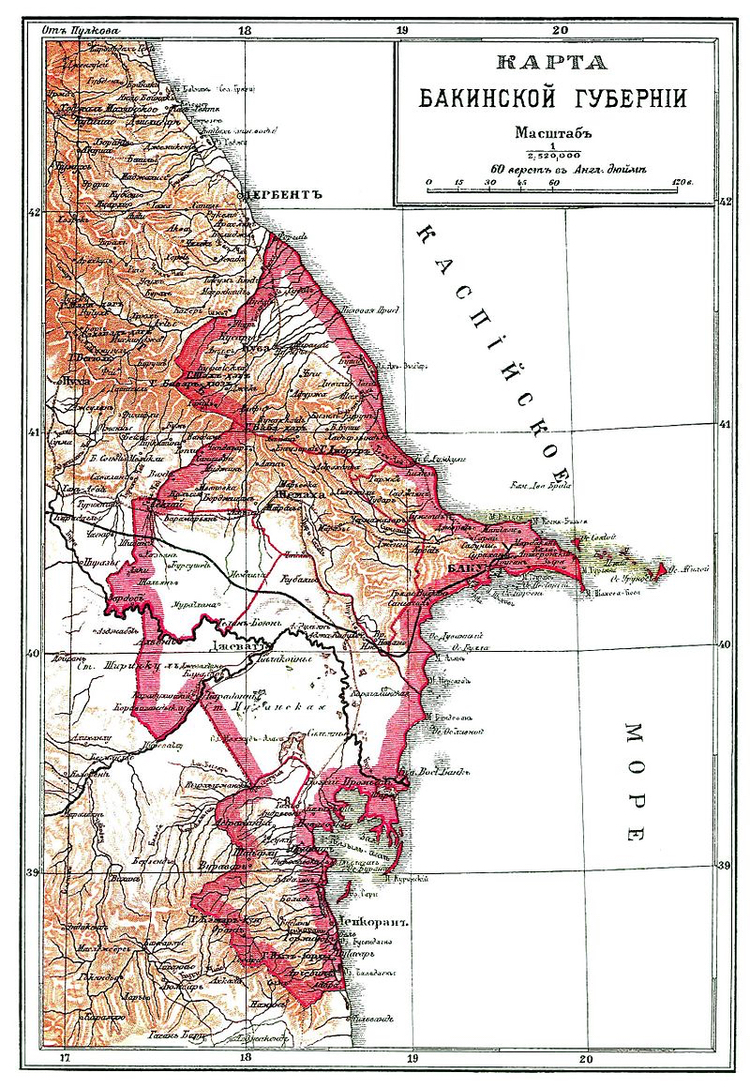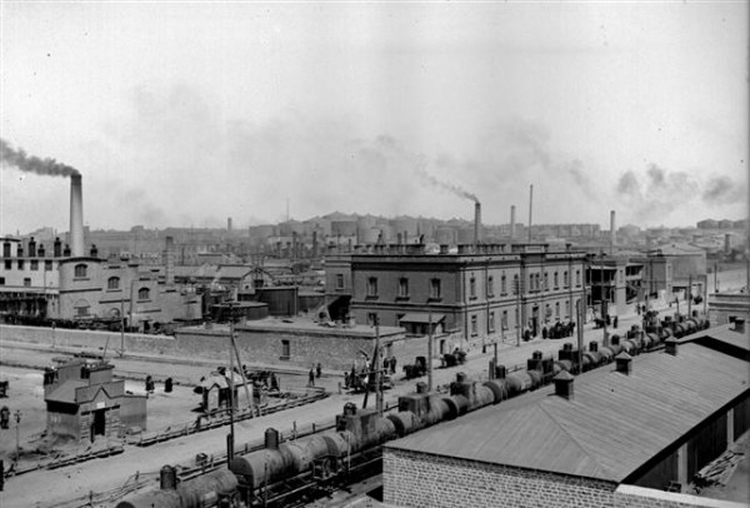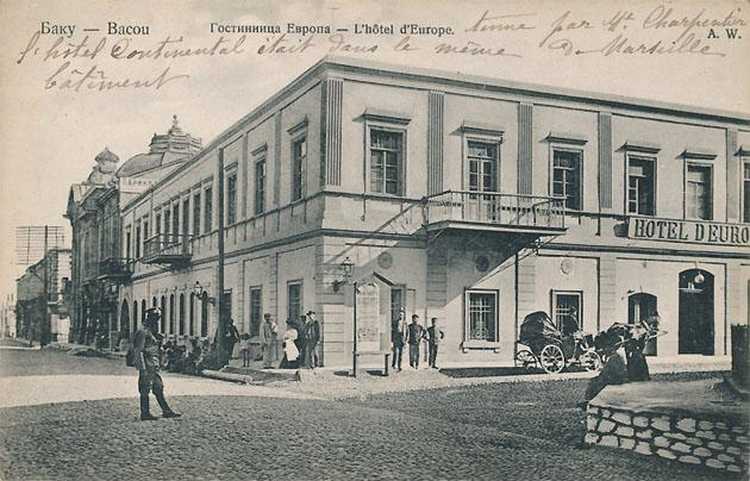The period of the Russian Empire
At the beginning of the XIX century, as a result of a large-scale attack of Tsar Russia on the South Caucasus the khanates of the Northern Azerbaijan fell one after the other. As a consequence of the occupation of the Baku Khanate on 6 October 1806, Baku was captured and passed to the control of the Russian Empire. During that period, Baku consisted of the Old City and several buildings built outside the fortification walls. In 1807, in Baku there were 500 buildings with 3,000 people, however, with growth of the population the city extended beyond the borders of the fortress walls.
In accordance with the Gulustan Treaty concluded in 1813, the accession of Northern Azerbaijan including Baku to the Russian Empire was approved. By 1849, the number of buildings in Baku reached 1,600, and the population grew to 8,120.

Following the occupation of Northern Azerbaijan by Russia, new administrative-territorial division began in order to implement the colonial policy of Tsarist Russia. Because of judicial and administrative reform on 10 April 1840, the provinces of Baku, Shusha, Nukha (Sheki), Lenkaran and Shamakha became uyezds, and the part of newly formed Caspian Oblast, and the Guba uyezd became part of Dagestan oblast.
Under the decree of Tsar Nicholas I issued on 14 December 1846, new changes were realized in administrative-territorial division of the South Caucasus. The territory was divided into Tiflis, Kutaisi, Shamakha and Derbent Governorates.
The uyezds forming part of the Caspian oblast were joint to Shamakha Governorate, and the Guba uyezd remained being part of Derbent Governorate. After the earthquake in Shamakha in 1859, the center of Shamakha Governorate was moved to Baku and it was renamed as Baku Governorate.
In December 1867, with the creation of Elisabethpol (Ganja) Governorate, Shusha and Nukha uyezds were taken away from the power of Baku Governorate and handed over to Elisabethpol Governorate. Due to the territory reduction of the uyezds adopted by the same decree, Javad and Goychay uyezds were established in the territory of Baku Governorate. Since then Baku Governorate consisted of 6 uyezds (Baku, Shamakha, Quba, Lenkaran, Javad and Goychay) and a number of islands in the Caspian sea. Such territorial division remained in the period of ADR as well.

Becoming the center of the guberniya made a major contribution to the rapid growth of Baku as an economically developed center. The annual production of oil at Absheron reached 200-300 thousand pounds. In 1847, in the settlement of Bibi-Eybat the first oil well was drilled using a primitive drilling mechanism. Until 1864, forced labor was used in oil production. In 1871, the first oil well started functioning in Balakhani.
The abolition of the forced labor system in the oil industry (1872) gave impetus to the development of this significant field of industry; thus, the inflow of foreign capital into the oil industry of Baku began.
In 1879, there were 9 boreholes in Baku, and in 1900, the number of boreholes reached 1,710. In 1873, 3.9 million pounds of oil were produced, and in 1895, the oil output reached 348 million pounds.
The Baku oil ousted the American oil from the Russian markets and reached the world level. In 1859, the first oil refinery was launched in Surakhani.
Beginning from 1873, in the Baku suburbs there began to appear a new oil refinery district known as "Black City". Soon after, oil refineries were built in Keshla and White City.
In Baku, along with the oil industry, other sectors of industry began to develop. Thus, mechanical plants, workshops, tobacco factories, steam-powered mills, etc., began to appear. Unfortunately, the tsarist authorities and the oilmen were not interested in the arrangement of the city. New constructions mainly consisted of houses of rich people, banks, commercial and industrial firms. The water treatment plant built in 1849 gave only 30 thousand buckets of water per day. Only in 1899, the second station of this kind was commissioned. In addition, there was no sewage in the city.
The rapid development of Baku and its surroundings required the establishment of transport communications, water and railway lines.

On 20 January 1880, a narrow railway connecting Baku with the industrial districts of Balakhani, Sabunchi, and Surakhani was put into operation. On 8 May 1883, the Baku-Tiflis railway line started working. In 1889, the first horse tram (city’s horse-drawn tram service) began to run in Baku. In 1900, the construction of the Petrovsk-Derbent-Balajari railway was completed, and the line was connected to the Grozny-Beslan railway. As a result, the merger of Baku with the Russian rail network has increased oil exports of Azerbaijan.
In the 40s of the XIX century, steam vessels had already been operated in the Caspian Sea. In 1859, construction of the Baku seaport began. In 1860, the “Caucasus and Mercury” Society dealing with shipping in the Caspian Sea owned 15 steam vessels. Consequently, the society had become a big company. In 1898, more than 40% of the cargo of the Russian navy accounted for the Caspian fleet.

Along with the vehicle systems, the communication sectors started to develop in Baku as well. In 1868, the Baku-Tiflis telegraph line was conducted, in 1879 – the Baku-Krasnovodsk line (on the seabed), and in 1886, the first telephone connection was constructed in the city. On January 1 of the same year, a district court was established in Baku. In August 1872, the Treasury Chamber was created for the purpose of assessing and collecting taxes, maintaining income and expenditure accounts. In January 1873, a local state supervision body - the Baku Supervisory Chamber - was established. The Chamber was entrusted with monitoring the Baku and Elisabethpol (Ganja) Governorate, the Dagestan Oblast and the Zakatala county. In spite of rapidly developing and becoming a large industrial and commercial center of Russia, Baku had no self-governing body. In late XIX - early XX century, oil production in Baku increased. By 1901, Baku produced more than half of the world's oil (667,1 million poods). There were dozens of oil refineries in Baku. Along with the oil industry, other fields of industry and trade had also been developing. The Baku industry, especially the oil industry, fell into the hands of monopolists.
There was a tendecy of concentration of workers in large enterprises. In Baku there were a machine-building, a metal-processing, ship-repair plants with 100-500 workers; as well as factories for the production of steam pans, etc.; shipyards, a textile factory with 2,000 workers, 2 tobacco factories, a cement factory, a distillery and a brewery, power stations, steam mills. A number of workshops for the repair of machinery and equipment, the production of building materials, household products operated in the city. At that period, printing had also been developing in Baku, a number of printing houses already existed. The turnover of maritime and rail routes increased. The crisis that struck Russian industry in 1900-03 affected the oil industry of Baku as well. As a result, many companies suspended oil production. Those years had seen a marked reduction in the volume of oil exports. Nevertheless, Baku still remained the center of the main oil industry of the Russian Empire. In 1909, there was a population of 22,2694 inhabitants in Baku.
At the beginning of the XIX century, being the major center of economic growth, Baku also played a valuable role in the life of the Russian Empire as a political and cultural development center.

Since the middle of the XIX century, the socio-political movement in Baku expanded. Here the local organizations of the All-Russian parties and national parties started working. The heavy colonial regime of tsarism facilitated the rise of the national liberation movement. The Russian revolution of 1905-07 played an important role in the political life of the city. In August-September 1905, the Armenians genocide against the Azerbaijanis was perpetrated with the participation of the royal power. However, this could not prevent the national liberation struggle of the Azerbaijani people. By the decree of Tsar Nicholas II (1894-1917) on 28 October 1906, the mayor's office of Baku was created. According to the “Caucasian Calendar” (1917), 405.829 people lived in Baku, of these, 173,489 people were local, 232,340 temporarily living.
Due to the February revolution in 1917, after the overthrow of the tsarist power, the Temporary Government established Special Transcaucasian Committee in the South Caucasus (OZAKOM, 9 March 1917). The local bodies included the executive committees of public organizations and the commissioners chosen by them. Following the takeover of power in Petrograd, the Bolsheviks strengthened their activities in Azerbaijan, especially in Baku.
As a consequence of the February revolution of 1917 in Russia, in all the cities including Baku, councils of workers and soldiers' deputies were created as a second authority. The Baku Council created by the integration of the Council of Workers' Deputies and the Council of Military Deputies considered the most influential among them.
The idea of Azerbaijani autonomy within Russia was for the first time declared in Baku Congress of Caucasian Muslims in April, and it was confirmed in the Congress of Russian Muslims taken place in Moscow in May 1917.
On October 31, the Bolsheviks requested that an emergency meeting of the Baku Soviet be convened, where the Bolsheviks with the participation of the representatives of oil-producing plants committees and military committees accepted the resolution about the capture of the authority.
In December 1917, new elections were held for the Baku Soviet. The new Executive Committee included six Bolsheviks, five Dashnaks, four Left SRs, three Right SRs, and two Musavatists. As a result of the events in the South Caucasus at the end of 1917 - the beginning of 1918, Azerbaijan regained its independence. Baku became the capital of the Azerbaijan Democratic Republic.
Reference used:
Azerbaijan National Encyclopedia. The third volume. Baku, 2011, p. 55-56. (in the azerbaijani language)
